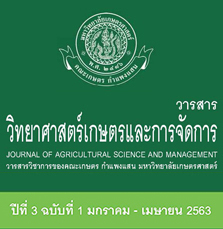การศึกษากลไกทางชีวเคมีของถั่วเขียวในการตอบสนองต่อสารอาทราซีนที่ตกค้างในดิน
คำสำคัญ:
อาทราซีน, เอนไซม์ต้านอนุมูลอิสระ, ถั่วเขียว, ยับยั้งกระบวนการสังเคราะห์แสง, ไทอาซีนบทคัดย่อ
สารอาทราซีนมีกลไกการเข้าทำลายพืชด้วยการขัดขวางการเคลื่อนย้ายของอิเล็กตรอนในกระบวนการสังเคราะห์แสง ส่งผลให้เกิดอนุมูลอิสระเกิดปฏิกิริยา peroxidation กับไขมันของเยื่อหุ้มเซลล์ เพื่อลดความเป็นพิษของสารกำจัดวัชพืชและลดความเสียหายจากการเกิดปฏิกิริยา oxidation ของออกซิเจน พืชจะมีกลไกการป้องกันตัวเองด้วยการสร้างเอนไซม์ต้านอนุมูลอิสระ ดังนั้นการทดลองนี้จึงมีวัตถุประสงค์เพื่อศึกษาประสิทธิภาพในการเคลื่อนย้ายอิเล็กตรอนในกระบวนการสังเคราะห์แสงของถั่วเขียว จำนวน 5 พันธุ์ ได้แก่ CNMB, CN84-1, KPS-2, KU4 และ KU8 ในการตอบสนองต่อสารอาทราซีนที่ตกค้างในดินที่ระดับความเข้มข้น 13.16, 23.42, 43.64, 89.56, 154.17, 308.16 และ 612.59 มิลลิกรัมต่อกิโลกรัมดิน นอกจากนี้ยังทดสอบกิจกรรมของเอนไซม์ต้านอนุมูลอิสระ ได้แก่ glutathione S-transferase (GST), superoxide dismutase (SOD), guaiacol peroxidase (GPX) และ catalase (CAT) จากผลการทดลองพบว่า การเคลื่อนย้ายอิเล็กตรอนในกระบวนการสังเคราะห์แสงของถั่วเขียวลดลง เมื่อความเข้มข้นของสารอาทราซีนเพิ่มขึ้น โดยที่ถั่วเขียวพันธุ์ CN84-1 สามารถทนทานต่อสารอาทราซีนที่ตกค้างในดินได้ ด้วยการสร้างเอนไซม์ GST และ CAT เพิ่มขึ้น ซึ่งความทนทานนี้จะอยู่ในระดับความเข้นข้นของอาทราซีน ประมาณ 23.42 มิลลิกรัมต่อกิโลกรัมดิน
เอกสารอ้างอิง
ทศพล พรพรหม. 2560. สารป้องกันกำจัดวัชพืช: หลักการและกลไกการทำลายพืช. สำนักพิมพ์แห่งจุฬาลงกรณ์มหาวิทยาลัย, กรุงเทพฯ. 405 หน้า.
สำนักงานนโยบายและแผนทรัพยากรธรรมชาติและสิ่งแวดล้อม. 2560. ฐานข้อมูลเพื่อการรายงานสถานการณ์คุณภาพสิ่งแวดล้อมของประเทศไทย: ข้อมูลตัวชี้วัดปริมาณการนำเข้าวัตถุอันตรายทางการเกษตร. แหล่งข้อมูล: onep.go.th/env_data/2016/01_60/ (22 สิงหาคม 2562).
Allen, M.M., A.C. Turnburke, E.A. Lagace and K.E. Steinback. 1983. Effects of photosystem II herbicides on photosynthetic membranes of the cyanobacterium Aphanocapsa 6308. Plant Physiology 71(2): 388-392.
Alves, C., E. Costa, J.R. Sofiatti, C.T. Forte, F.L. Winter, C.M. Holz, R.R. Kaizer and L. Galon. 2018. Effect of herbicides in the oxidative stress in crop winter species. Anais da Academia Brasilera de Ciencias 90(2): 1533-1542.
Asada, K. 2006. Production and scavenging of reactive oxygen species in chloroplasts and their functions. Plant Physiology 141(2): 391-396.
Buono, D.D. and G. Ioli. 2011. Glutathione s-transferases of Italian ryegrass (Lolium multiflorum): activity toward some chemicals, safener modulation and persistence of atrazine and fluorodifen in the shoots. Journal of Agricultural and Food Chemistry 59(4): 1324-1329.
Cotgreave, I.A., P. Moldeus, R. Brattsand, A. Hallberg, C.M. Andersson and L. Engman. 1992. Alipha-(phenylselenenyl)acetophenone derivatives with glutathione peroxidase-like activity: a comparison with ebdselen. Biochemical Pharmacology 43(4): 793-802.
Cummins, I., D.J. Wortley, F. Sabbadin, Z. He, C.R. Coxon, H.E. Straker, J.D. Sellars, K. Knight, L. Edwards, D. Hughes, S.S. Kaundun, S.J. Hutchings, P.G. Steel and R. Edwards. 2013. Key role for a glutathione transferase in multiple-herbicide resistance in grass weeds. PNAS 110(15): 5812-5817.
Curran, B. and D. Lingenfelter. 2012. Herbicide persistence and rotation to cover crops. (Online). https://extension.psu.edu/herbicides-persistence-and-rotation-to-cover-crops. (January 20, 2020).
Department of Agriculture. 2007. The use of agricultural chemicals in Thailand. Division of Agricultural Toxic Substance, Bangkok, Thailand.
Giannopolitis, C.N. and S.K. Ries. 1977. Superoxide dismutases. I. occurrence in higher plants. Plant Physiology 59(2): 309-314.
Havir, E.A. and N.A. McHale. 1987. Biochemical and developmental characterization of multiple forms of catalase in tobacco leaves. Plant Physiology 84(2): 450-455.
Jerzykiewicz, J. and G. Klobus. 2007. The effect of Triazine- and Urea-type herbicides on photosynthetic apparatus in cucumber leaves. Acta Societatis Botanicorum Poloniae 76(1): 43-47.
Jiang, Z., B. Ma, K.O. Erinle, B. Cao, X. Liu, S. Ye and Y. Zhang. 2016. Enzymatic antioxidant defense in resistant plant: Pennisetum americanum (L.) K. Schum during long-term atrazine exposure. Pesticide Biochemistry and Physiology 133: 59-66.
Kesari, R. and V.K. Gupta. 1998. A simple method for the spectrophotometric determination of atrazine using p-aminoacetophenone and its application in environmental and biological samples. Talanta 47(5): 1085-1092.
Li, J., X. Wei and T. Peng. 2005. Fabrication of herbicide biosensors based on the inhibition of enzyme activity that catalyzes the scavenginging of hydrogen peroxide in thylakoid membrane. Analytical Sciences 21(10): 1217-1222.
Ma, R., S.S. Kaundun, P.J. Tranel, C.W. Riggins, D.L. McGinness, A.G. Hager, T. Hawkes, E. McIndoe and D.E. Riecher. 2013. Distinct detoxification mechanisms confer resistance to mesotrione and atrazine in population of waterhemp. Plant Physiology 163: 363-377.
Meloni, D.A., M.A. Oliva, C.A. Martinez and J. Cambraia. 2003. Photosynthesis and activity of superoxide dismutase, peroxidase and glutathione reductase in cotton under salt stress. Environmental and Experimental Botany 49(2003): 69-76.
Ponnusamy, J., S. Neelam, C. Chinnusamy and N. Sakthivel. 2015. Herbicide residues and their management strategies. Indian Journal of Weed Science 47(3): 329-344.
R Development Core Team. 2014. R: language and environment for statistical computing. R foundation for statistical computing. (Online). http://www.R-project.org. (May 20, 2017).
Ramel, F., C. Sulmon, M. Bogard, I. Couée and G. Gouesbet. 2009. Differential patterns of reactive oxygen species and antioxidative mechanisms during atrazine injury and sucrose-induced tolerance in Arabidopsis thaliana plantlets. BMC Plant Biology 9(1): 28.
Robinson, D.E. 2008. Atrazine accentuates carryover injury from mesotrione in vegetable crops. Weed Technology 22(4): 641-645.
Rohde, W.A., L.E. Asmussen, E.W. Hauser, M.L. Hester and H.D. Allison. 1981. Atrazine persistence in soil and transport in surface and subsurface runoff from plots in the coastal plain of the Southern United States. Agro-Ecosystems 7(3): 225-238.
Sergiev, I., V. Alexieva, S. Yanev and E. Jiang, L. and H. Yang. 2009. Prometryne-induced oxidative stress and impact on antioxidant enzymes in wheat. Ecotoxicology and Environmental Safety 72(6): 1687-1693.
Shah, S.M., M.A. Khan and M.Y. Mirza. 2000. Effect of pre-emergence herbicide on soya bean yield. Sarhad Journal of Agriculture 16: 57-59.
Singh, G. and D. Wright. 2002. Effect of herbicides on nodulation and growth of two varieties of pea (Pisum sativum). Acta Agronomica Hungarica 50(3): 337-348.
Sofia, A., R. Perveen, I.I. Naqvi and S.S. Shaukat. 2003. Effect of atrazine on absorption and translocation of P32, chlorophyll, carbohydrate, protein and potassium contents in bean Vigna radiate (L.) Wilczek. Pakistan Journal of Biological Sciences 6(3): 249-251.
Song, N.H., X.L. Yin, G.F. Chen and H. Yang. 2007. Biological responses of wheat (Triticum aestivum) plants to the herbicide chlorotoluron in soils. Chemosphere 68(9): 1779-1787.
Trebst, A. 2007. Inhibitors in the functional dissection of the photosynthetic electron transport system. Photosynthesis Research 92(2): 217-224.
Wang, M. and Q. Zhou. 2006. Effect of herbicide chlorimuron-ethyl on physiological mechanisms in wheat (Triticum aestivum). Ecotoxicology and Environmental Safety 64(2): 190-197.
Yan, F., W. Yang, X. Li, T. Lin, Y. Lun, F. Lin, S. Lv, G. Yan, J. Liu, J. Shen, Y. Mu and G. Luo. 2008. A trifunctional enzyme with glutathione S-transferase, glutathione peroxidase and superoxide dismutase activity. Biochimica et Biophysica Acta 1780(6): 869-872.






